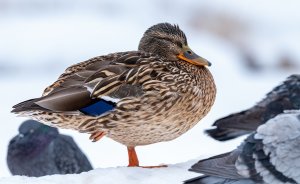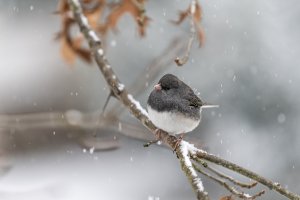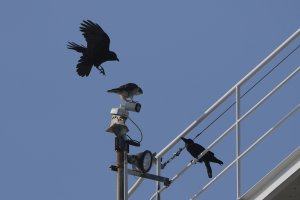Corvid’s Declassified Winter Survival Guide: sustained by seeds, thriving on chaos.
November 29, 2023
Ali Groulx, park interpreter
Birds are not governed by reason. They have a hierarchy, they have politics, they have friends and foes… all of which can be clearly observed in the wintertime. The ones who cannot tough it out migrate south. To survive Michigan winters, birds need to prepare themselves for a time of scarcity and high energy cost. With a little investment of time from curious citizen-scientists like you, we can help career-scientists study bird behaviors at a greater level than before. Citizen-scientists provide key insights into the hierarchies, friendships, and frequency of bird species, which is especially crucial in the winter when weighing the effects of climate change. Delve into the winter lives of chickadees, titmice, nuthatches, woodpeckers, the ever-formidable corvids, water birds, and birds of prey who call Michigan home, 24/7/365 days a year.
After all the leaves have fallen from the trees, we can finally see the hidden spots that birds used to raise their young. Birds build nests in many places, but only the structurally sound nests high up in the trees will be observable during this time of year, especially if they are not covered in snow! Despite common belief, birds do not use their nests as homes during the winter. To keep themselves warm at night, birds huddle together in large flocks, exchanging body heat and shivering to keep themselves unfrozen. As endotherms, birds are warm-blooded and can generate their own heat. Birds use their dynamic and moveable feathers to use their body heat to warm the trapped air between their feathers and skin. On a chilly day, there is a good chance you might catch a bird all puffed up! What about those little scaley legs, though? Bird feet contain little fluid and are mostly bone and tendon, covered by protective scales. Fast-beating hearts and close together blood vessels allow their blood to move through their feet quickly which allows the blood to stay warmer when it moves through their toes, meaning birds rarely get frostbite. If they are just hanging out, birds will often stand on one foot while perched, keeping the other warm by tucking it into their feathers.

Mallards often stay during the wintertime in Michigan. These common ducks find their food on the bottom of lakes and ponds, using their comb-like bill to sift through the debris at the bottom of the water to find things to eat. Mallards and other ducks have a special gland on their bodies that makes an oily substance. By using their special bills, ducks gather oil and comb it into their feathers, which makes their feathers water-tight and keeps their skin dry, allowing them to float in the water when us humans deem it unacceptable to do so. A lot of water birds migrate south for the winter, following their favorite foods and warmer temperature, only coming back to Michigan when the time is right. There are birds that migrate HERE, though, like the dark-eyed junco and the snowy owl. These birds like to follow slightly warmer temperatures as the seasons change across the globe. You may catch dark-eyed juncos patrolling the ground around your bird feeders; these little guys strictly feed off the ground, so they are easy to spot once you know what they look like.

Different birds have different diets during the wintertime. Many small birds, like chickadees, titmice, and nuthatches store nuts and seeds for the wintertime, making sure they have a supply ready just in case they cannot find any food. Citizen scientists have observed birds visiting their bird feeder, only to fly a few feet away to stash a seed in the bark of a tree. This behavior is called caching. Many other animals do this, too, like squirrels. As you observe the birds in your backyard, you may notice that woodpeckers are active, too. Woodpeckers like the downy, hairy, and red-bellied woodpecker all enjoy eating hibernating insects from inside tree bark, and they also like to eat and cache seeds like the smaller birds. However, there is a species of bird that has figured out ways to easily disperse their bird feeder competitors, and those are blue jays.
To understand blue jays, it is important to know their family. Blue jays are from the corvid family, which also includes crows (and ravens, etc). Corvids have powerful brains like ours that allow them to mimic sounds and problem solve, and they really can get up to some interesting antics. After spending years of watching the little birds eat all the good seeds, blue jays realized that every time a red-tail hawk would screech, the little birds would scatter from the bird feeder, scared by a potential predator. Blue jays have learned that they can use their mimicry skills to impersonate scarier birds, tricking the littler ones into leaving the bird feeder. Birds that have more body mass do not get as cold as smaller birds do. This means that in the winter, our intelligent crow friend has more time during the day for fun activities, like mobbing birds of prey. Owls, hawks, and eagles have a hard time hiding themselves in leaf-less winter trees, causing them to become prime targets for harassment. If a crow family spots a red-tail hawk in a tree monitoring the ground for prey, it is game on. Crows will swoop, circle, caw, and harangue the hawk for hours… and for what? Well, sometimes the day to day of surviving winter gets a little boring for the know-it-all crow. Their mobbing behavior in turn keeps smaller birds safer, too, as the bird of prey’s location is well-known once mobbing begins. The hawk will eventually leave to find a new hunting location, away from the crows.

If you have not begun your journey into becoming a citizen scientist, all it takes is a pair of observant eyes! Wintertime bird counts are very important to ornithologists, or bird-scientists, as it gives fantastic metrics for populations of local and migrating birds. Keeping a bird feeder can be an entertaining and awesome learning opportunity to share with your loved ones. There is no better time to become a ‘bird-nerd’ than in the winter! When you keep track of the birds visiting your feeder, you are helping career-scientists by providing them with local, real time data. Information about the upcoming Audubon Society’s 124th Christmas Bird Count can be found here, or you can explore all things bird feeders and citizen science at Project Feeder Watch.
SOURCES AND FURTHER READING:
How do birds survive the winter?
How do tiny chickadees survive the frigid cold?
A Guide to Nature in Winter by Donald Stokes
Bird Behavior, volumes 1-3 by Donald Stokes
